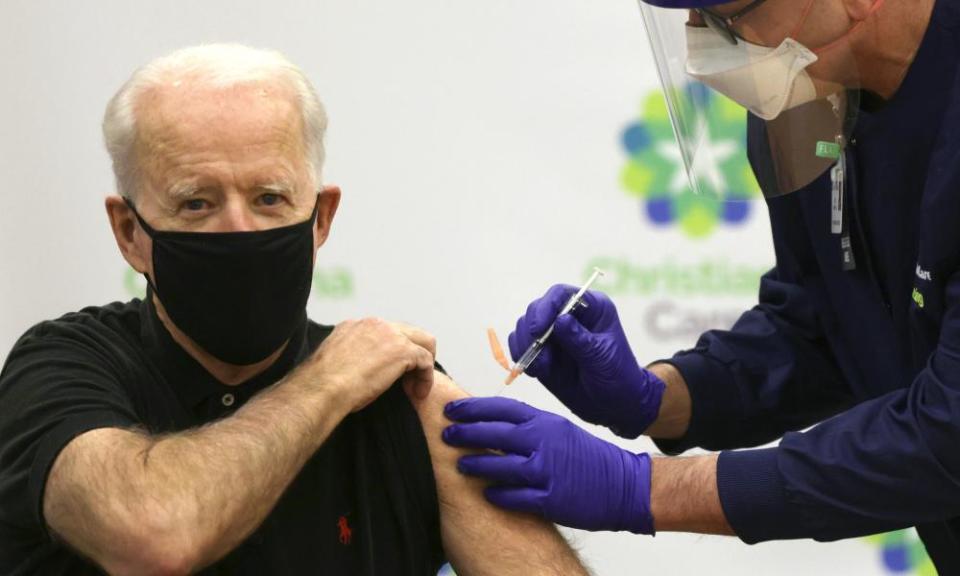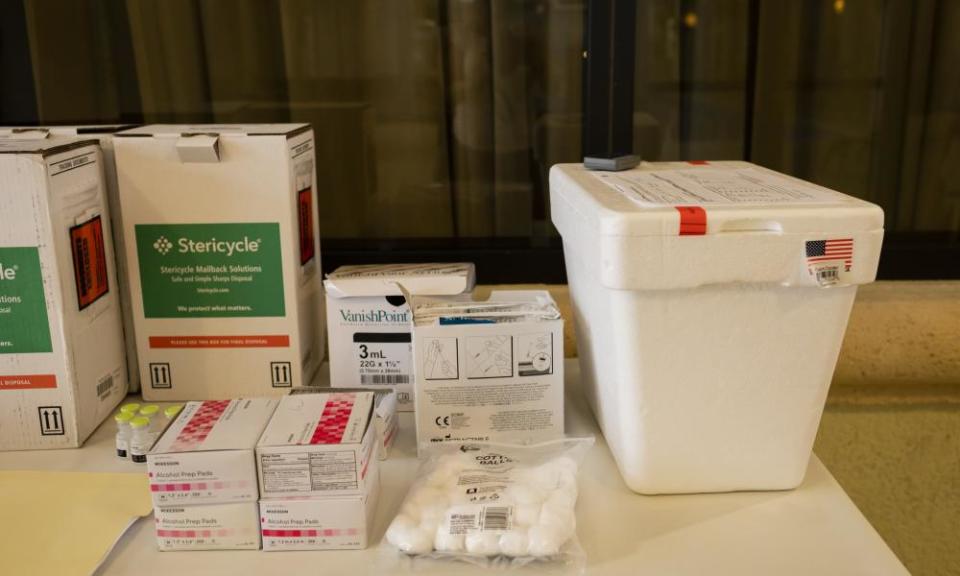Biden team plan shake-up to get coronavirus shots into US arms

The star scientists and determined technocrats running Joe Biden’s program to defeat Covid-19 know they have been given a huge boost by the brilliant invention in record time of multiple effective coronavirus vaccines.
In addition to two vaccines already approved for emergency use in the United States, “it’s really likely that in the next three months that there will be as many as three others”, said Wayne Koff, an outside expert and president of the Human Vaccines Project.
Related: 'Inheriting a mess': grim outlook for Biden goal of 100m Covid vaccinations in 100 days
So the United States is firmly on course to produce more than enough coronavirus vaccine to immunize the population in a time frame that one year ago many would have thought impossible.
But as Biden prepares to assume the presidency on Wednesday, and his team prepares to radically expand the national vaccination project, officials warn that a failure on the part of the Donald Trump administration to plan adequately for the distribution and administration of vaccine doses threatens to squander the advantage gained from quick vaccine development.
Biden advisers also warn that as fast as vaccine development is moving, the virus is also accelerating, with at least three variants taking hold worldwide, and the looming prospect in the US of such an explosion of coronavirus cases that no vaccine administration program could keep pace.
“What Operation Warp Speed did is, they did all this work and spent many billions of dollars to get vaccines to manufacturing status and approval, and then said, ‘Oh, the rest of it will just happen’,” said Michael Osterholm, a member of Biden’s Covid-19 advisory board, in his podcast as director of the Center for Infectious Disease Research and Policy. Operation Warp Speed was the name given to the Trump administration’s vaccine development program.
The United States has witnessed “an incredible technology miracle to bring these vaccines through,” Osterholm said, but “an incredible communication and rollout strategy failure”.
The vacuum of planning for vaccine distribution before Biden takes office appears to have been so vast that the challenges ahead are basic. In recent public statements, the Biden team members have described a forward focus on the who, where and why: who gets the shots, where the shots happen and explaining why – for hesitant patients – vaccination is vital.
In a speech in Delaware on Friday, Biden filled in some details of his plan, saying his administration would build vaccine stockpiles, open new vaccination sites and hire more staff while answering Americans’ basic questions about what is in the shots.

“One of the things that is really needed, I think, right off the bat, is a communications approach such that everybody understands what is going on, what the expectations are,” said Koff. “And they get an understanding of where they are in line.”
For now, people are confused. Each state has its own rules for who is eligible for vaccination, but those guidelines sometimes contradict federal guidelines, and the number of doses allotted to states by Washington in many cases does not line up with the number of supposedly “eligible” state residents.
Fueling the confusion was a sudden and unforeseen shift on Tuesday in Trump administration guidelines that exponentially grew the pool of eligible vaccine recipients from healthcare workers and long-term care facility residents – about 24 million people total – to include anyone 65 and older, plus non-healthcare essential workers and young people with pre-existing conditions – about 180 million people.
There aren’t nearly enough doses yet to vaccinate that many people, and no expert ever thought there would be at this stage – but the hastily altered guidelines have created a sense of false scarcity with the public. The states of New York, Florida, California and others have witnessed a crush of demand, interminable waits in queues or on the phone and online, growing frustration among residents and zero available appointments in many places.
“I think that was a really unfortunate step, it certainly did not match up with reality, and I think what we’ll be seeing is that state and local health departments are going to continue to be the shock absorbers because they don’t have enough doses,” said Osterholm.
In other areas, excess doses have led to public calls for willing patients, and in some cases patient no-shows have caused doses to be spoiled and thrown out. Hospitals and other healthcare facilities, already overwhelmed by Covid patients, do not have the staff to administer vaccines, while plans to set up vaccination stations elsewhere, such as inside pharmacies, have not gotten off the ground.
As with most healthcare questions in America, no one is sure what health insurance will pay for or how much it will cost.
The complications have seen the vaccination effort fall far behind projections. The Trump administration announced in November that 20 million Americans would be vaccinated by year’s end. A fraction of that number – just more than 1.3 million Americans – had received the required two vaccine doses as of Friday, according to the Centers for Disease Control and Prevention (CDC).
“Right now it’s kind of like the wild west, with each state doing its own thing,” said Koff.
To tame the chaos, the Biden team has described an approach that is both aggressive and flexible, planning to move almost all of the existing vaccine stockpile out the door immediately – counting on the ability of manufacturers to keep up with demand for second doses – and tailoring distribution strategies on a local basis.

“The federal vaccination recommendations have just been very hard to operationalize on the ground, very complicated,” Biden adviser Celine Gounder, a New York-based clinician and medical professor, said on Thursday in a forum hosted by the Johns Hopkins school of public health. “And so we essentially need to make things simpler, whether that means simplifying the supply chain or simplifying the tiers of who is eligible for vaccination.”
In unveiling a new, $1.9tn Covid-19 relief proposal on Thursday night, Biden called for $20bn for vaccination efforts and $50bn for testing, and he repeated his promise that 100m shots would be administered in his first 100 days in office – a number achievable at the current rate of dose administration.
The moving parts of the Biden plan include coordination with states on the who-where-why basics; communicating to the public what’s happening; standing up vaccination sites inside pharmacies, school gyms, community centers and sports stadiums and establishing mobile sites for marginalized communities and recruiting community members to lead outreach. It will also draw personnel and resources from the Federal Emergency Management Agency, the CDC, the Pentagon and the national guard, fund more medical staff in general and expand genomic surveillance to track virus variants.
Another Biden adviser, Loyce Pace, president of the Global Health Council, praised Biden’s selection of the Yale medical professor Marcella Nunez-Smith to lead the effort to ensure equal access for racial and ethnic minorities to vaccines and treatments.
“We’re hopeful that that is going to signal a central focus on those communities moving forward,” Pace told the Johns Hopkins event.
But vaccine hesitancy in general, and especially in some communities of color, remains a top concern.
“If you consider which communities of color have been subjected to enslavement, and which communities of color have been the victims of medical experimentation, that has by – and large been African Americans and indigenous communities,” said Gounder. “So of course you’re going to see more hesitancy in those communities. And I don’t think you can bulldoze through that just by educating, quote-unquote.”

Other key players on the Biden team include Rochelle Walensky, CDC director-designate; Vivek Murthy, surgeon general-designate; Covid coordinator Jeff Zients, an Obama administration veteran who led the effort to fix healthcare.gov after the web site’s flawed rollout; and deputy coordinator Natalie Quillian, a former partner at Boston Consulting Group. David Kessler, a former director of the Food and Drug Administration, was named head of vaccine science for the Covid response on Friday.
The team will take over just as the United States appears to be cresting a new tsunami of virus cases. Covid-19 is currently the leading cause of death in the US. The rate of daily deaths has surpassed 4,000 and daily new cases have touched 300,000. Currently more than 131,000 people are hospitalized for Covid.
A highly infectious variant of the virus first detected in the UK has been detected in at least 11 states, and assuming that the United States will fail to put effective isolation measures in place, the variant could produce previously inconceivable spikes in new cases, hospitalizations and deaths, according to health officials.
“The good news is the current vaccines appear to be effective against the UK variant, and it is really important that we do everything we can to accelerate our current vaccine programs,” Osterholm said.
But research on two other variants, one tied to South Africa and one tied to Brazil and Japan, to determine whether they might be resistant to vaccines or drugs used for treatment has not been completed.
“This is a stay-tuned moment,” Osterholm said.
In his speech on Thursday, Biden underscored the magnitude of the challenge.
“This is going to be one of the most challenging operational efforts we have ever undertaken as a nation,” he said. “We’ll have to move heaven and earth to get more people vaccinated.”

 Yahoo News
Yahoo News 
